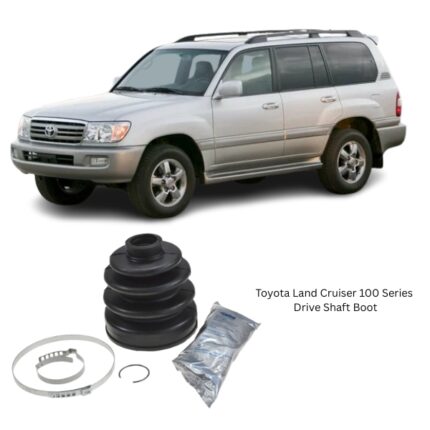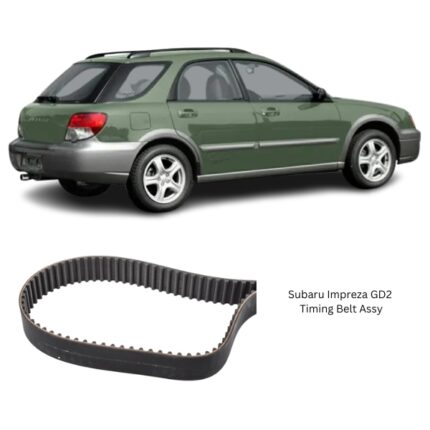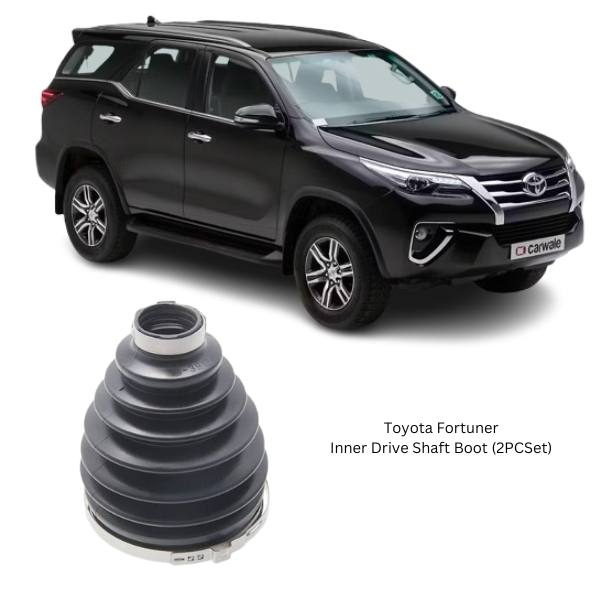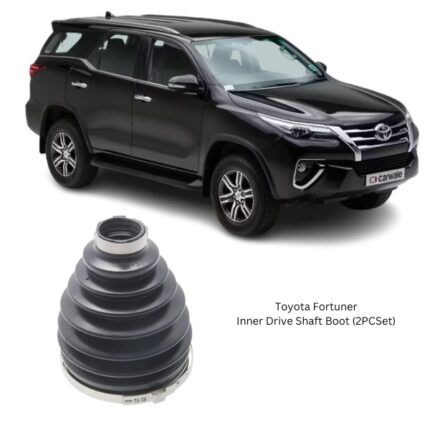-9%
Get Toyota Fortuner Inner Drive Shaft Boot (2PCSet) 04427-0k020 in Kenya
The Inner Drive Shaft Boot, also known as the inner CV boot, is a small yet crucial component in a vehicle’s drivetrain system. Its primary responsibility is to protect the inner constant velocity (CV) joint, a part of the drive shaft that allows for controlled movement while transmitting torque from the transmission or differential to the wheels.
Though simple in appearance, the inner drive shaft boot serves as a flexible barrier between the CV joint and the harsh environment beneath the vehicle. It keeps grease in and contaminants out—ensuring the joint operates efficiently, remains lubricated, and avoids premature failure. If the boot fails, the CV joint is left vulnerable to damage, potentially leading to significant repair costs and impaired vehicle performance.
Function and Importance
The inner CV joint is located where the drive shaft connects to the transaxle or differential. It accommodates the up-and-down motion of the suspension and allows the axle to change length as the suspension articulates. The Inner Drive Shaft Boot covers this joint, creating a sealed environment that retains lubrication and blocks external elements.
Key Functions of the Inner Drive Shaft Boot:
-
Protects the CV Joint from Contamination
Prevents dirt, water, sand, and road debris from entering the joint housing and damaging the internal bearing surfaces. -
Retains Lubricating Grease
The CV joint relies on constant lubrication to reduce friction and minimize wear. The boot keeps this grease contained within the joint area. -
Accommodates Motion
Designed with a flexible bellows shape that expands and contracts as the suspension moves, ensuring freedom of motion without compromising the seal. -
Prolongs Component Life
Maintains optimal operating conditions for the CV joint, extending its service life and preventing the need for premature axle replacement.
Design and Construction
The Inner Drive Shaft Boot is engineered for durability, flexibility, and resistance to environmental factors. Despite its modest size, it is built to endure extreme mechanical and environmental stress.
Common Structural Elements:
-
Bellows Section
The center of the boot is designed in a ribbed or accordion-style shape that allows it to flex and stretch in rhythm with the drive shaft and suspension movement. -
Inner and Outer Ends
Each end of the boot is designed to fit securely—one end clamping onto the axle shaft, the other onto the CV joint housing. These ends are typically fastened with stainless steel clamps or durable zip ties to ensure a leak-free seal.
Materials Used:
-
Neoprene Rubber
A popular choice due to its excellent resistance to oil, heat, and road chemicals. It offers a long service life and maintains flexibility in a wide range of temperatures. -
Thermoplastic Elastomers (TPE)
Increasingly used in modern vehicles, TPE provides strength and temperature stability, though it is less flexible than neoprene. -
Silicone (in performance or premium applications)
Provides superior heat resistance and flexibility, though typically reserved for performance vehicles or heavy-duty applications.
The chosen material must withstand constant flexing, rotation, road impacts, and exposure to elements like salt, oil, and heat.
Performance Characteristics
When properly installed and functioning, the Inner Drive Shaft Boot:
-
Maintains a clean, sealed environment around the CV joint
-
Preserves optimal joint lubrication
-
Ensures quiet and smooth drive performance
-
Withstands repeated flexing without cracking or tearing
-
Prevents internal corrosion of the joint components
-
Contributes to consistent torque delivery from the engine to the wheels
It is particularly vital in front-wheel drive, all-wheel drive, and some rear-wheel drive vehicles where the inner CV joint must articulate significantly under load and during cornering.
Common Symptoms of a Faulty Inner CV Boot
Despite being built for durability, the inner boot can degrade over time due to heat, road debris, aging, or improper installation.
Signs of Boot Wear or Failure:
-
Visible Cracks or Tears
A visual inspection reveals cracking, tearing, or complete splits in the boot material—especially around the folds. -
Grease Leakage
Grease leaking onto nearby components or the underbody indicates a breached boot that can no longer contain the lubricant. -
Contaminated Grease
Grease mixed with dirt or water (often dark or gritty in appearance) suggests the boot is no longer sealing out contaminants. -
Vibrations While Driving
A damaged CV joint—often the result of a failed boot—can cause vibration under acceleration or load. -
Clicking or Knocking Sounds
More commonly associated with outer boots, but in some cases, severe inner CV joint wear may cause audible symptoms during rapid acceleration or turning. -
Loosened or Missing Clamps
If the clamps securing the boot come loose, the boot can shift or allow grease to escape.
Installation and Replacement
Replacing an Inner Drive Shaft Boot is a moderately technical job best done by trained mechanics or experienced DIYers with the right tools.
General Replacement Procedure:
-
Lift the Vehicle and Remove the Wheel
Safely raise and support the vehicle to gain access to the axle assembly. -
Disconnect the Drive Shaft
Remove the axle from the transmission or differential and the wheel hub, as needed. -
Remove the Damaged Boot
Cut or slide off the old boot and inspect the joint for wear, rust, or contamination. -
Clean and Re-Grease the CV Joint
Thoroughly clean the joint and pack with manufacturer-approved high-temp CV joint grease. -
Install the New Boot
Slide the new boot over the shaft and joint, and secure it with new clamps or bands. -
Reinstall the Axle Assembly
Torque bolts to specifications and check alignment. A post-installation road test and inspection are recommended.
Maintenance and Inspection Tips
-
Inspect boots during routine oil changes, tire rotations, or suspension work.
-
Check for signs of swelling, brittleness, or leaks.
-
Ensure clamps are tight and show no signs of rust or movement.
-
Replace both boots on an axle if one is worn—this balances wear and saves future labor.
Timely inspection and replacement can prevent catastrophic CV joint failure, avoid breakdowns, and reduce long-term maintenance costs.
Advantages of Timely Boot Replacement
-
Preserves expensive CV joints
-
Maintains smooth torque transmission
-
Prevents breakdowns due to joint failure
-
Reduces drivetrain vibration and noise
-
Avoids further suspension or steering component damage
-
Saves labor and repair costs over time
A small investment in preventive maintenance of the inner boot can translate into thousands in repair savings.
Follow us on Facebook for more parts.





Reviews
Clear filtersThere are no reviews yet.